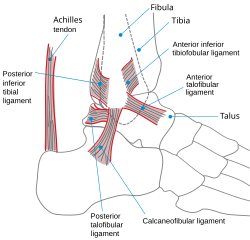Talocrural articulation
| Ankle | |
|---|---|

Lateral view of the human ankle
|
|
| Details | |
| Identifiers | |
| Latin | tarsus |
| MeSH | A02.835.583.378.062 |
| Dorlands /Elsevier |
a_64/12161605 |
| TA | A01.1.00.041 |
| FMA | 9665 |
|
Anatomical terminology
[]
|
|
The ankle, or the talocrural region, is the region where the foot and the leg meet. The ankle includes three joints: the ankle joint proper or talocrural joint, the subtalar joint, and the inferior tibiofibular joint. The movements produced at this joint are dorsiflexion and plantarflexion of the foot. In common usage, the term ankle refers exclusively to the ankle region. In medical terminology, "ankle" (without qualifiers) can refer broadly to the region or specifically to the talocrural joint.
The main bones of the ankle region are the talus (in the foot), and the tibia and fibula (in the leg). The talocrural joint is a synovial hinge joint that connects the distal ends of the tibia and fibula in the lower limb with the proximal end of the talus. The articulation between the tibia and the talus bears more weight than that between the smaller fibula and the talus.
The bony architecture of the ankle consists of three bones: the tibia, the fibula, and the talus. The articular surface of the tibia is referred to as the plafond. The medial malleolus is a bony process extending distally off the medial tibia. The distal-most aspect of the fibula is called the lateral malleolus. Together, the malleoli, along with their supporting ligaments, stabilize the talus underneath the tibia.
The bony arch formed by the tibial plafond and the two malleoli is referred to as the ankle "mortise" (or talar mortise). The mortise is a rectangular socket. The ankle is composed of three joints: the talocrural joint (also called talotibial joint, tibiotalar joint, talar mortise, talar joint), the subtalar joint (also called talocalcaneal), and the Inferior tibiofibular joint. The joint surface of all bones in the ankle are covered with articular cartilage.
...
Wikipedia
